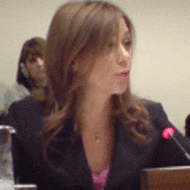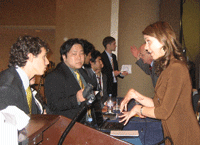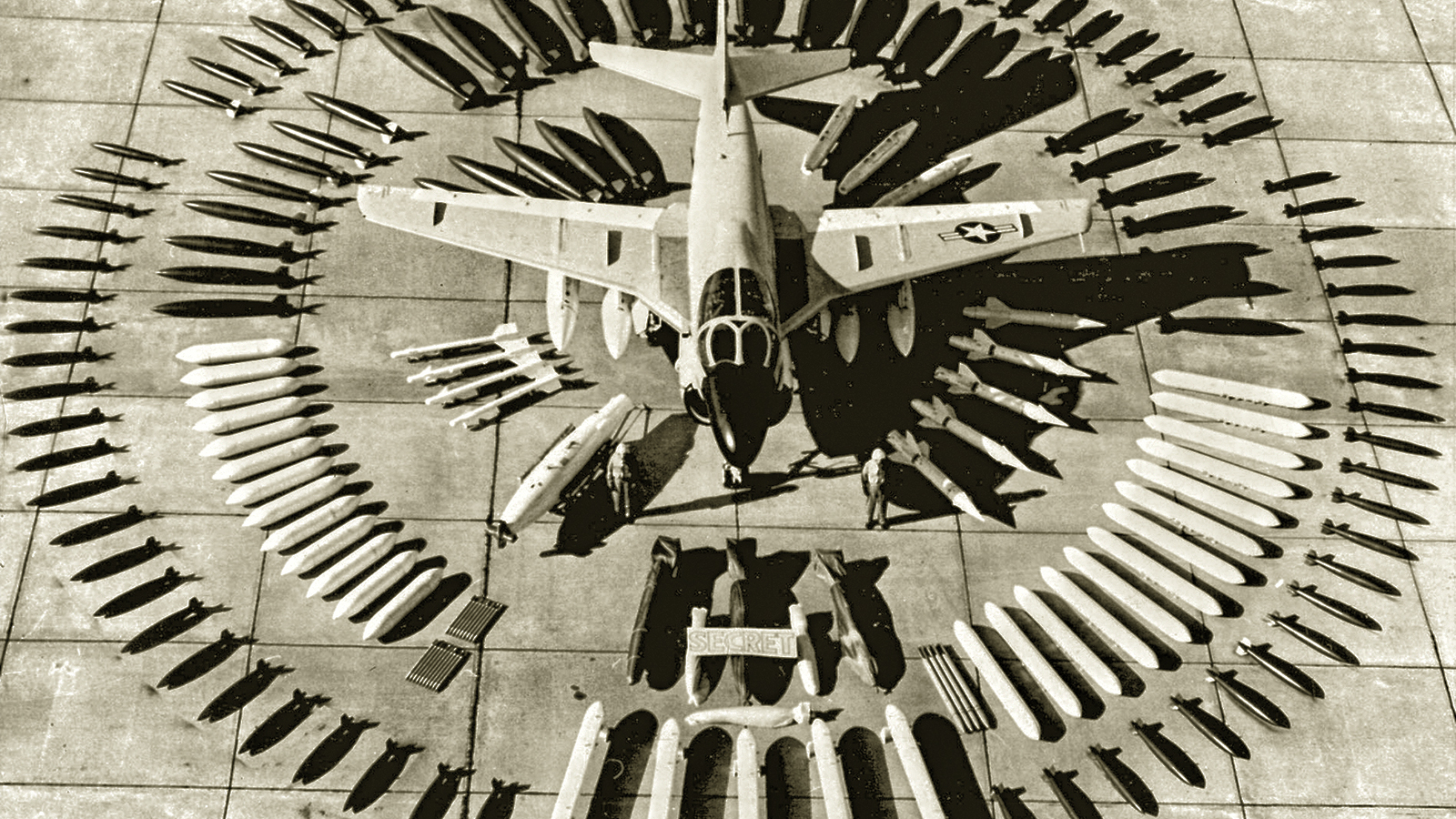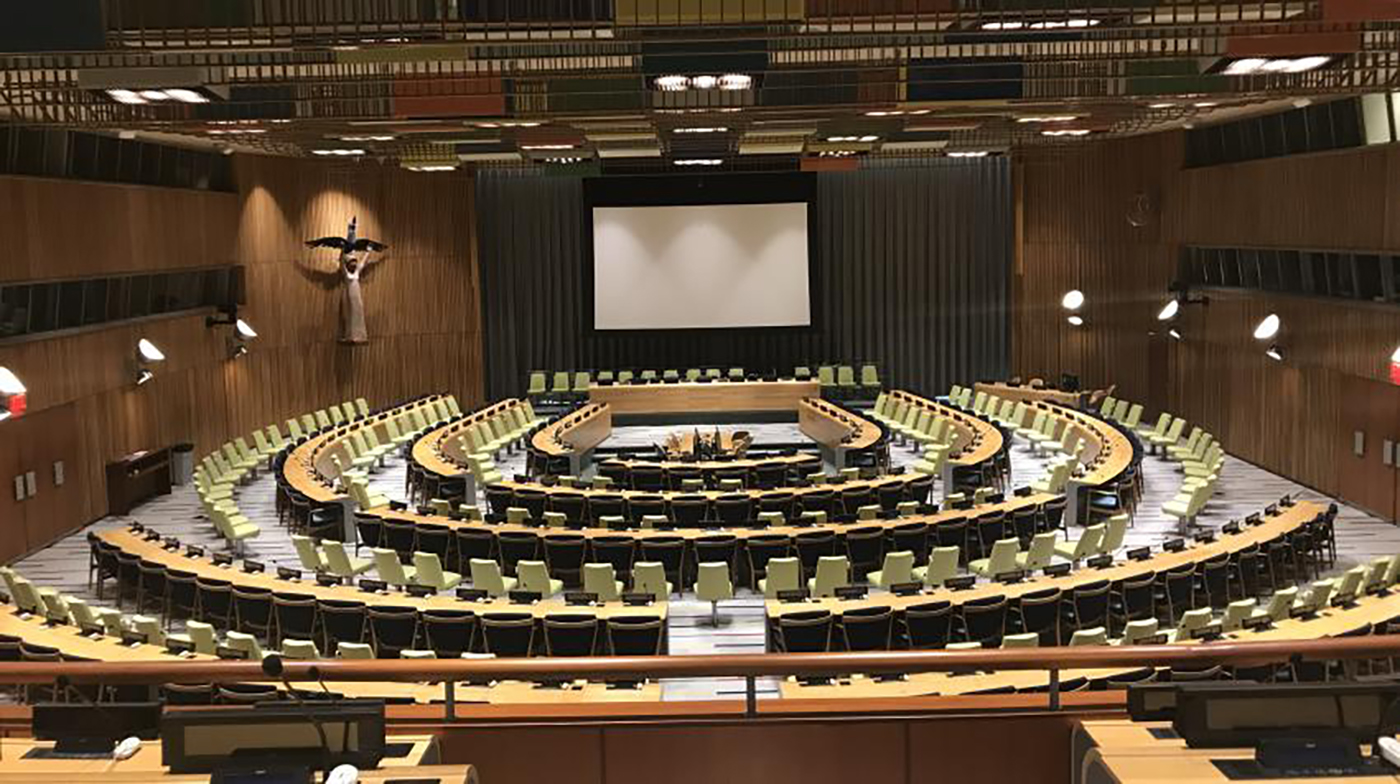Presentation by Rhianna TysonSenior Officer of the Global Security Institute prepared for the Model United Nations convention Thanks again to the organizers for inviting me back here to discuss nuclear disarmament and non-proliferation to this outstanding group of young people. From briefly observing what is taking place here, I can only jealously regret that I did not have a Model UN program in my high school or college. As someone who has been to dozens of UN and other intergovernmental meetings over the past 5 years, I can tell you that, in terms of professionalism and possibly in productivity, this gathering is the equal to any going on over on 1st avenue or in Geneva, or at least the ones dealing with disarmament.
I’m going to start with some quotes by some pretty famous people, just to give you a sense of what we’re talking about, and who’s talking about it: “Current US nuclear weapons policy is immoral, illegal, militarily unnecessary, and dreadfully dangerous…To launch a weapon against a nuclear-equipped opponent would be suicidal. To do so against a nonnuclear enemy would be militarily unnecessary, morally repugnant and politically indefensible.”[1] [Nuclear weapons are] “totally irrational, totally inhumane, good for nothing but killing, possibly destructive of life on earth and civilization.” [2] “It is becoming clearer that nuclear weapons are no longer a means of achieving security; in fact, with every passing year they make our security more precarious.” [3] “Reliance on nuclear weapons for [the purpose of deterrence] is becoming increasingly hazardous and decreasingly effective.” [4] These aren’t quotes from leftwing activists. They’re not quotes by Congressional Democrats like Nancy Pelosi or even Dennis Kucinich. Nor are they from critics of the US like Chavez or Kim Jung Il or Ahmadinejad. Does anybody here know who said these statements, calling for the abolition of nuclear weapons? They are, verbatim, the opinions of (in order) former Secretary of Defense Robert McNamara, President Ronald Reagan, President Mikhail Gorbachev and former Secretaries of State Henry Kissinger and George Schultz, the hawkish Senator Sam Nunn and former Secretary of Defense William Perry. That’s right. These architects of nuclear deterrence, the cold warriors who practiced a theory of mutually assured destruction as mad as its acronym warned, believe today that the only real, sustainable way to mitigate the threats posed by nuclear weapons is through their global elimination. And starting, moreover, by reducing our nuclear weapons. Its not a change of heart, necessarily, or a way for these aging men who nearly brought us to the brink of annihilation several times to ensure that, when push comes to shove, they find themselves on the good side of the pearly gates. In fact, in their widely heralded op/eds in the Wall Street Journal—from whence I took that last quote—Kissinger et al reiterated the justification for their longstanding position of supporting a hefty US nuclear arsenal, back in the day: “Nuclear weapons were essential to maintaining international security during the Cold War because they were a means of deterrence.” But, they continued to say, “The end of the Cold War made the doctrine of mutual Soviet-American deterrence obsolete.” These prominent figures recognize that today’s threats are fundamentally different from the threats that they faced whilst in government, and the old solutions, namely those that rely on nuclear weapons as a means of security, not only don’t work, but are contributing to the gravity and perpetuation of the current threats. Nukes 101 But before I talk about the 21st century nature of the nuclear threat today, I’d like to briefly review some basic facts about nuclear weaponry. I fear that all too often, policy planners, diplomats and other decision-makers and influencers talk about these weapons and craft policies surrounding their use without really taking a moment to think about what, exactly, a nuclear weapon is. I don’t want you future diplomats here to fall into that same bad habit. The bomb that obliterated Hiroshima on August 6, 1945 was roughly a 15 kiloton nuclear weapon. 90,000 people were killed immediately, with 50,000 more dying of radiation sickness and other related effects in the coming weeks and months. Three days later, 74,000 people were instantly killed by a similar bomb dropped over Nagasaki, with 75,000 more dying in the proceeding weeks and months. Both cities were totally destroyed, buildings leveled, roads disintegrated, unleashing what former survivor-turned-mayor Iccoh Itoh called “a calamity that came upon Nagasaki like a preview of the Apocalypse.” After the atomic bombing of Hiroshima and Nagasaki in 1945, other countries rushed to join the United States in the “nuclear club”; the United Kingdom tested its first weapon in 1952, the followed by the Soviet Union (1953), France (1960) and China (1964). Eager to curb the proliferation trend, the US and the Soviet Union, spurned on by a UN resolution drafted by Ireland, led negotiations that resulted in the nuclear Non-Proliferation Treaty or NPT, which prevented any other states from acquiring nuclear weapons, with the lone exceptions of India, Israel and Pakistan. (North Korea, mind you, was a party to the Treaty, until it withdrew in 2003 and subsequently developed nuclear bombs, though they still lack a means of delivery.) Besides these hold out states, every other country in the world is a party to this Treaty, making it the most popular security treaty in the history of the world, with the exception of the UN Charter itself. Today, there are about 30,000 nuclear weapons (down from the 1980s height of 60,000), with over 95% of them in the arsenals of the US and Russia, and the remaining 1,500 possessed by the others. Most of the weapons deployed today represent about 8 times the destructive capacity as the Little Boy bomb that exploded over Hiroshima. During the Cold War, when the arms race was hitting truly burlesque proportions, the Soviets tested the RDS-220 or Big Ivan, a weapon equivalent to over 3,000 Hiroshimas at over 50 megatons, and the US tested the B-41, a weapon equivalent to over 1,500 Hiroshimas. These destructive forces looming over humanity’s head exceed the capacity of the mind to grasp. A couple of other not-so-fun facts of our nuclear reality:
Just to put these last two not-so-fun facts together in a truly absurd situation: In 1995—after the cold war had ended and the “Evil Empire” relegated to the history books—Russian radars picked up a travelling rocket that had a similar trajectory as a US Trident nuclear-armed missile would have. Russian operating rules allowed President Yeltsin less than ten minutes to decide a course of action: wait and see if it was a mistake or launch a nuclear retaliatory strike. Thankfully, other early warning systems indicated conclusively that the rocket—which was, incidentally a scientific rocket launched off the coast of Norway—was indeed not heading towards The Motherland, and Yeltsin did not destroy the planet. Back to not-so-fun-facts: 4. There are 2,360,000 pounds of existing Russian weapons-grade fissile material, with much of it vulnerable to theft or diversion by terrorists or hostile organizations. If you think that’s scary, consider the next not-so-fun fact: 5. Only 8-10 pounds of fissile material are necessary to build a crude nuclear bomb. A missile is not needed to deliver such a device; a tugboat or truck could be used. 6. Forty-four countries are capable of developing nuclear weapons. These countries have access to the fissile material and technology to build nuclear weapons. The threat today For those who don’t think about nuclear weapons every day as some of us do, I would argue that, at least in the global north, there are two threats at the forefront of most people’s minds—that of climate change and that of terrorism. Clearly, nuclear weapons do not guard against the threats posed by receding shorelines, melting icecaps, shrinking rainforests and oceanic pH level distortions. (“Stop warming, globe! Or we’ll nuke you!” Not quite.) Not only do nuclear weapons do nothing to combat this threat to our planet, but they actually exacerbate the risks caused by it. Perhaps you’ve heard the term “nuclear winter”, coined first by scientists in the 1970s studying the possibilities of a full-scale nuclear exchange between the US and Russia. More recent studies by climatologists, however, show that even a so-called “limited” nuclear exchange would result in similar “nuclear winter” effects that would seriously jeopardize the planet. A small nuclear exchange, say, in South Asia, would result in a massive cloud of smoke and soot that would lodge itself in the Earth’s stratosphere, effectively blocking out the sun’s rays for years, even decades. The results on the climate would be catastrophic. Consider the effects it would have on global food supplies alone. Millions would starve and dozens, if not hundreds of local conflicts would erupt over dwindling resources, each of which take on their own form and dynamics. Ok, so what then of terrorism? As if terrorism by box cutters isn’t scary enough, the possibility of nuclear terrorism sends most people into shock. Horrifying, of course, but keep in mind that the chances of a non-state actor acquiring a nuclear weapon, replete with a means of delivery, are quite low. Nuclear terrorism, however, would more likely come in the form of a so-called “dirty bomb”, i.e. radioactive materials dispersed through a conventional weapon. While such a weapon would lack the apocalyptic mushroom cloud of a nuclear weapon, it would nonetheless kill or poison thousands of people in the target area. Terrorists, they say, work outside the ‘normal’ parameters of logic and are thus undeterrable, ergo, the threat of retaliation and ensured destruction—the foundation of M.A.D. theory—is useless against these crazed individuals. Moreover, the more weapons we have, the more materials that are made worldwide, the easier it will be for a terrorist to acquire them. The elimination of them, therefore, is the best way to prevent terrorist theft and use of nuclear weapons. Even nuclear terrorism aside, what use is a nuclear weapon, with unconscionably indiscriminate effects, arguably that run counter to the laws of war, against a band of terrorists, against non-state actors? Beyond the possible illegality of using a nuclear weapon in retaliation or prevention of a terrorist attack, it is unquestionably immoral. There is just no use for a nuclear weapon in defending against a terrorist threat. None. So the question therefore that I pose, specifically to the Americans, the French, the Brits, the Chinese, and the Russians in here— do your nuclear weapons make you feel secure? I hold this truth to be self-evident: If you are pointing nuclear weapons at someone, someone is pointing them at you. Right now, right at this moment, thousands of nuclear weapons on hair-trigger alert are literally pointed at you, here in New York City. This ridiculous scenario is not the same for people in Stockholm or Rio de Janeiro, or other cities in countries whose governments have given up the pursuit of nuclear weapons. (Yes, both Sweden and Brazil, as well as Argentina, South Africa and a few others at one time did have active nuclear weapons programs.) Furthermore, the greatest stimulus to the unacceptable spread of nuclear weapons is the refusal of the current nuclear weapon states to fulfill their legal obligation under the NPT to get rid of the weapons they have. That is why every state in the world signed up to the treaty in the first place, after all—the promise of total disarmament “at an early date”, as well as a right to get the technology for nuclear energy. (That latter point is a Faustian bargain if ever there was one, but I don’t have time to get into that right now.) As long as some countries have these weapons, others will want and eventually get them. Mohamed ElBaradei, Director-General of the IAEA, summed it up thus: You cannot tell somebody not to smoke with a cigarette dangling from your mouth. So how do we all, then, collectively stop smoking? Sure it may be difficult, but if we want to ensure that nobody—not our friends, not our enemies, nobody—ever starts smoking, we have to quit ourselves. It may be difficult, but, like quitting cigarettes, our “need” for nuclear weapons is as merely psychological, and just as dangerous, as a smoker’s “need” for nicotine. It is, I am certain, assured death. Thankfully, the path to a nuclear weapons-free world has already been staked out. Non-governmental organizations like mine have articulated steps that will put us clearly on that redemptive path. We at the Global Security Institute, working through a program of ours called the Middle Powers Initiative, have identified several steps that can be taken now, steps that do not diminish the security of any state, which reinforce the NPT and enhance the rule of law, which make the world safer now, and which move the world towards the elimination of nuclear weapons.[6] Each of the measures that we advance—at the UN, in foreign ministries around the world, in Congress and other parliaments and at strategic civil society events– decrease risks of use, diminish the access of terrorists to catastrophic weapons and materials to build them, raise barriers to acquisition by additional states and generate support for strengthening the global regime and resolving regional crises. These steps include:
The steps that we have hashed out through an ongoing consultative process with experts and governmental officials are nearly identical to the ones that were identified in those much heralded, oft-cited Wall Street Journal op/eds by the former cold warriors. As they wrote in their most recent piece, “In some respects, the goal of a world free of nuclear weapons is like the top of a very tall mountain. From the vantage point of our troubled world today, we can’t even see the top of the mountain, and it is tempting and easy to say we can’t get there from here. But the risks from continuing to go down the mountain or standing pat are too real to ignore. We must chart a course to higher ground where the mountaintop becomes more visible.” People like Kissinger and McNamara haven’t always been publishing pieces on nuclear abolition in the mainstream media. For far too long, people who opposed nuclear weapons were marginalized and regarded as unrealistic, or, at worst, anti-American. But now, thanks in large part to the WSJ op/eds, the vision of a United States, and an entire world, without nuclear weapons has been legitimated as attainable, pro-national security, and beyond the paradigm of partisan politics. Over 2/3 of the 24 living former national security advisers, secretaries of state and defense—from both parties—have given their general support to the ideas of abolition as expressed in the WSJ op/eds.[7] The political space that has been created in the past two years is remarkable, and possibly unprecedented, with the exception of the squandered opportunity of the end of the Cold War. So in conclusion, the threats to global, collective and human security in the 21st century are unlike any we as a species have ever known. Nuclear weapons not only fail to address them, but they cause more problems than any problem they purport to solve. Moreover, the international cooperation that our problems necessitate cannot be engendered in the shadow of the untenable security paradigm maintained through our current nuclear apartheid system, where the means of “security” for some are denied to others. You here at the Model United Nations are learning the tools necessary to cooperate across borders and through cultures. These skills that you are building will be invaluable as we continue on into this scary and exciting new century. You are preparing for challenges that know no borders, that transcend cultures, and which hold all of us on the planet at risk. You are truly contributing to the advancement of civilization into an era of cooperation like none that has been required of us before. The founder of my organization, a visionary American Senator named Alan Cranston, understood that nuclear weapons are immoral, and they are unworthy of civilization. The work that you are preparing for here is the antithesis of nuclear weaponry, and I thank you all for contributing to a safer and saner planet for us all.
[2] Quote from Ronald Reagan, as cited in Schultz et al (see footnote 4) [3] Gorbachev, Mikhail, “The Nuclear Threat,” The Wall Street Journal, January 31, 2007. [4] Schultz, George P., William J. Perry, Henry A. Kissinger, and Sam Nunn, “A World Free of Nuclear Weapons,” The Wall Street Journal, January 4, 2007. See: http://gsinstitute.org/gsi/newsletter/newsletter_2007-01-17.html#wsj [5]Schwartz, Stephen I. Atomic Audit: The Costs and Consequences of US Nuclear Weapons Since 1940. Brookings Institution Press, Washington: 1998. [6] See, for instance, “Towards 2010: Priorities for NPT Consensus,” Middle Powers Initiative Briefing Paper, April 2007. http://gsinstitute.org/mpi/docs/Towards_2010.pdf [7] See “‘Toward a Nuclear-Free World’: Reaganites against the bomb,” by Tyler Wigg Stevenson and Jessica Wilbanks, Sojourners, April 2008. http://gsinstitute.org/gsi/archives/000313.html
|







